
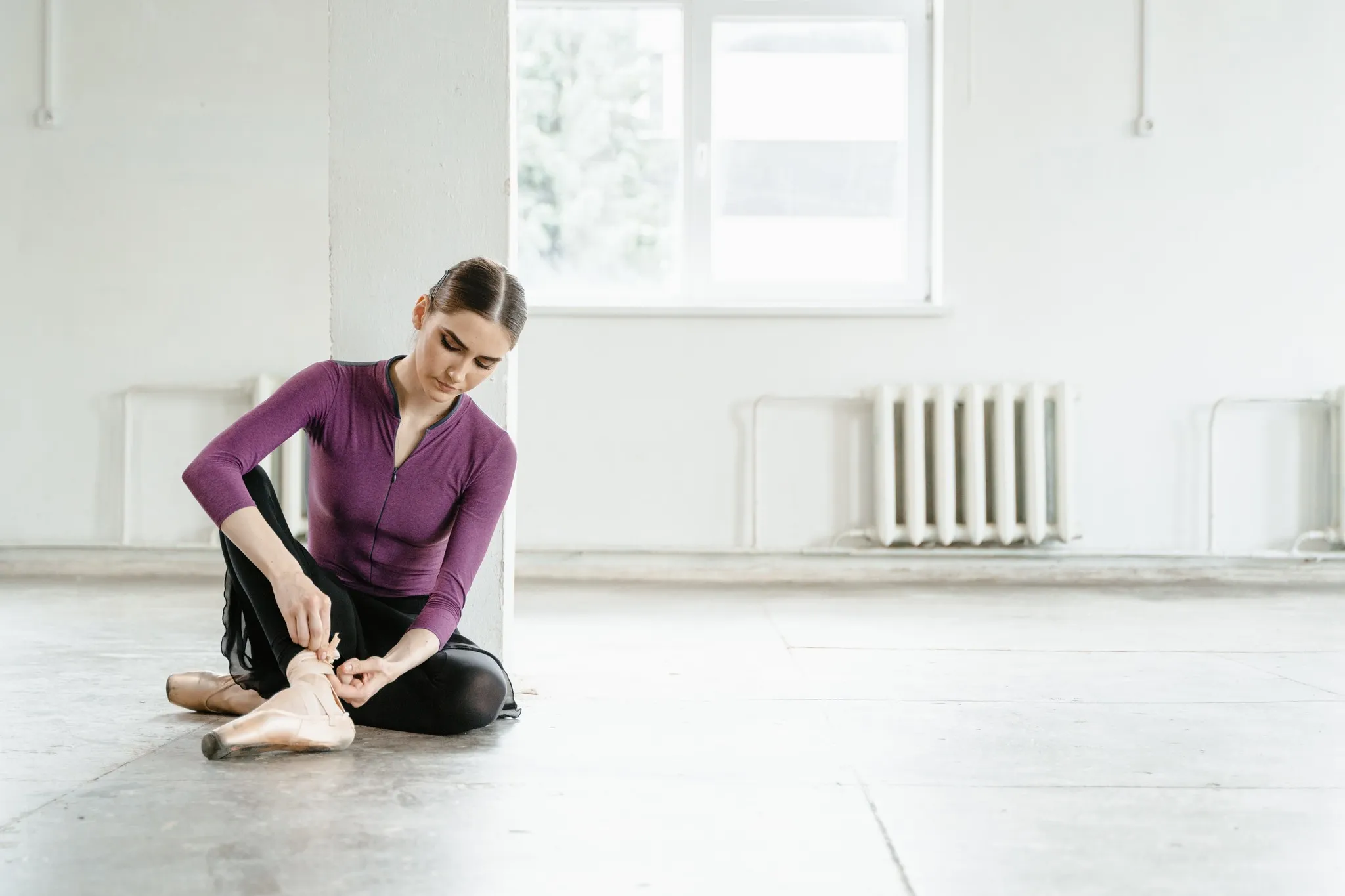
If you’re a dancer then you already know — dancing requires the kind of full-body muscular control that’s much more involved than just being graceful on your feet. To be a good dancer, you need a high level of body awareness, muscle tone and flexibility. But that’s not all — dancing also requires control over your breathing to execute those delicate moves with ease.
If you’re looking to become a better dancer, or improve your existing skill set, yoga can help you gain more flexibility, strength, balance, and master your breathing. Yoga can also help improve your posture and alignment, and boost your concentration, awareness, and your well-being.
Most dancers come to yoga with a preset level of flexibility most students don’t have. That’s why it’s important to take it slow if you’re just starting to practice yoga. It may be tempting to push too hard and overdo it. Like dancing, yoga poses require specific alignment — performing poses incorrectly can lead to injury.
Depending on your goals, there are multiple styles of yoga that may be right for you. For a flowing practice of yoga that often mimics dancing, Vinyasa yoga can help you gain more flexibility and movement that compliments your dance performance. Like Vinyasa, Power yoga can sometimes involve flowing movement, but it's a style more focused on building strength and balance.
Hatha, Iyengar, and Ashtanga yoga can also help improve your balance and posture, and these types of yoga typically involve some kind of breath work (or pranayama). If you need to unwind and destress while stretching sore and overworked muscles, Yin yoga or Restorative yoga can help you relax with gentle poses that are held for longer periods of time.
[inline-CTA-1]
Of course, you can get started with some basic poses to help improve your dancing skills in the comfort of your own home. Try the poses below for a basic primer on dance-friendly yoga poses.
.webp)
Tree pose is an excellent pose for improving your balance and posture.
Stand in Mountain pose with your feet hip distance apart. Keep your arms relaxed at your sides while you focus on an easy, steady breath. Transfer your body weight to your left foot, while softly bending your right knee, pulling it into your chest. Place the sole of your right foot on the inside of your left thigh. Keep your spine and head straight, with your gaze forward. Once you’ve steadied your balance, bring your hands together in Namaste formation. Hold for 5-6 deep breaths.
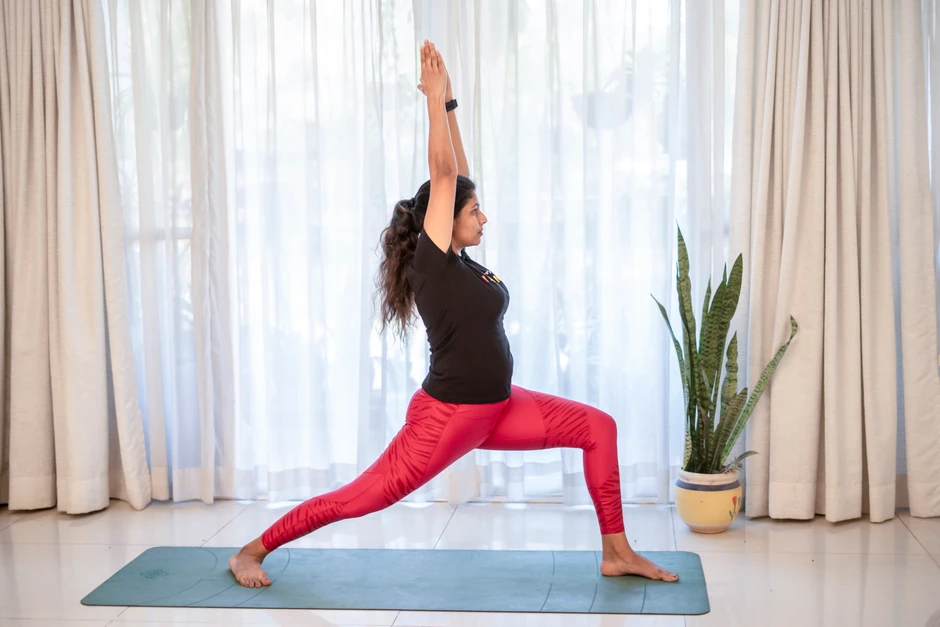
Warrior I is both lengthening and strengthening, giving your legs a workout while stretching your upper body.
Stand in the center of your mat with your weight evenly balanced on both your feet. Step your right foot forward with your toes pointed toward the front of the mat. Angle your left (back) foot slightly. Bend your right knee at 90 degrees while keeping your left leg flexed and engaged. Inhale and lift your arms up toward the ceiling. Gently arch your back and lift your chest. You can keep your gaze facing forward, or look up toward your hands to further open your chest. Hold for 30-60 seconds and then repeat on the other side.

This pose also improves your balance while strengthening your legs.
From the center of your mat, step your right foot forward. Drop your left hand to your side while reaching your right hand forward. Touch the tip of the mat with your right hand as you inhale and lift your left leg off the floor. Ground your right foot into the mat, and gently straighten your right leg. Lift and extend your left arm so that it is stretching up toward the ceiling, and lengthen your left leg as it extends toward the back of the room. Keep your head in a neutral position and your gaze facing forward. Hold for 3-4 breaths.

The perfect pose for dancers, this posture works on your balance, focus, and alignment.
Stand in the middle of your mat with your weight evenly balanced on both feet. Shift your weight onto your left foot, while bending your right knee and grabbing your right foot with your right hand. Lift your left arm up toward the ceiling. Bend at your waist and slowly lean forward, lifting your right leg and engaging your core. For better balance, focus your gaze on a fixed point in front of you. Hold for 3-5 breaths, then repeat on the other side.
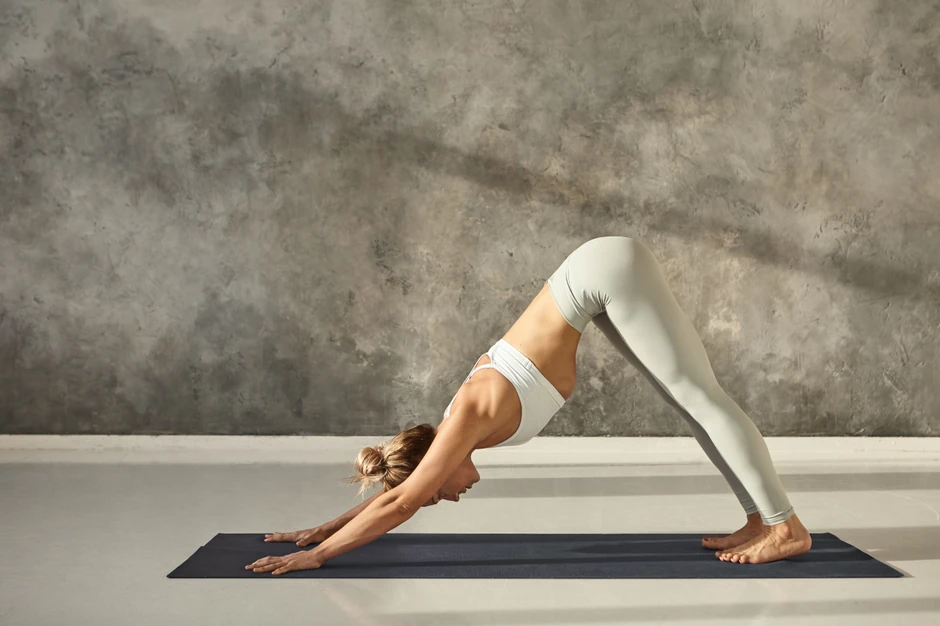
One of the basic primary poses, Downward Facing Dog stretches your calves, hamstrings, and lower back.
With your hands and knees on the floor, push your hips upward until you are balancing on your hands and feet, and your body resembles an inverted “v” shape. Reach your heels toward the floor, stretching your hamstrings and activating your thighs. Keep your head between your arms, lengthening your side-body as you stretch. Stay here for several breaths.

For incredible balance and core strength, try practicing Plank pose at least once every day.
Start with your hands and knees on the floor in tabletop position, with your hands placed shoulder-width apart. Engage your core and lift the backs of your thighs toward the ceiling until your body is positioned in a straight line from your heels through your crown. Tuck your tailbone and press down with your heels as you hold this pose for 30-60 seconds.
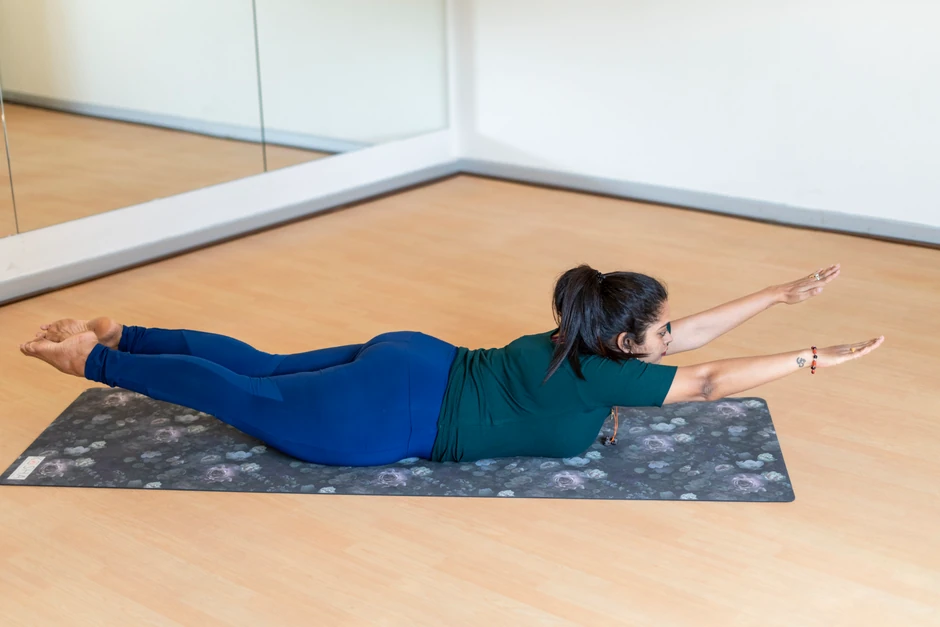
Locust builds strength in your lower back and spine while stretching your core.
Lie face down on your mat, resting your forehead on your forearms and your legs stretched straight out behind you. With an inhale, extend your arms to your sides and lift your lower legs off the mat, keeping your upper legs (thighs and core) flat on the mat. Engage your glutes and press both of your legs together while holding them up. Hold this pose for 5-6 breaths.
Range of motion in your hips is important for dancing, and Fixed Angle pose stretches your hip muscles while relieving tension in your lower back.
Sit on your yoga mat with your knees bent and the soles of your feet pressed against each other. With your spine straight, press your hands behind you and gently open up your chest and tuck in your abdomen. Hold the pose for 1-2 minutes.
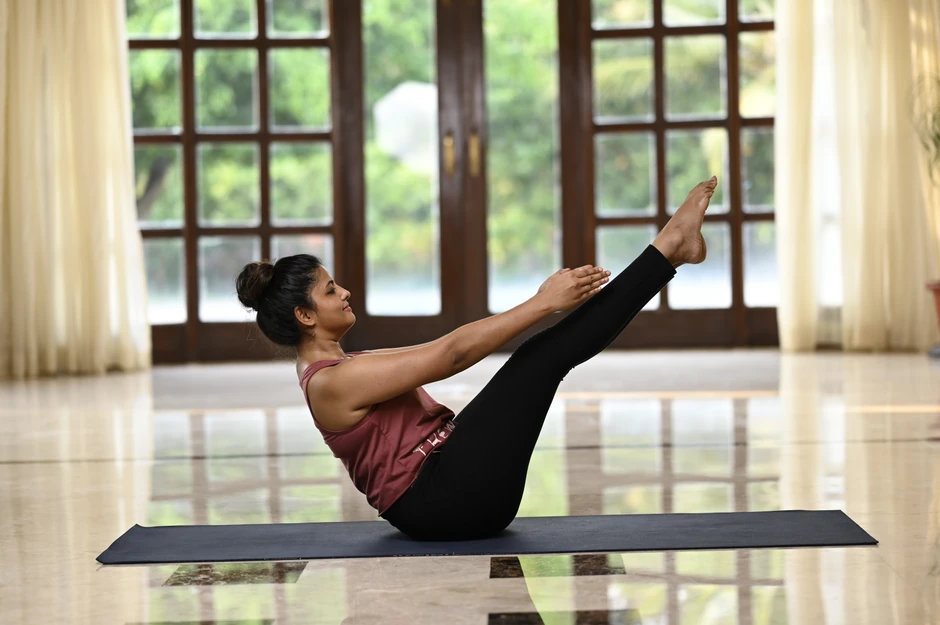
Another great posture for core strength, Boat pose works your abdominal muscles and improves your balance.
Sit on your mat with your knees bent and your hands at your sides. Engage your core, and gently lift and straighten your legs and your arms together, forming your body into a “v” shape. Keep your gaze focused on a fixed point in front of you, your chest open and your spine straight. Hold for a few breaths.
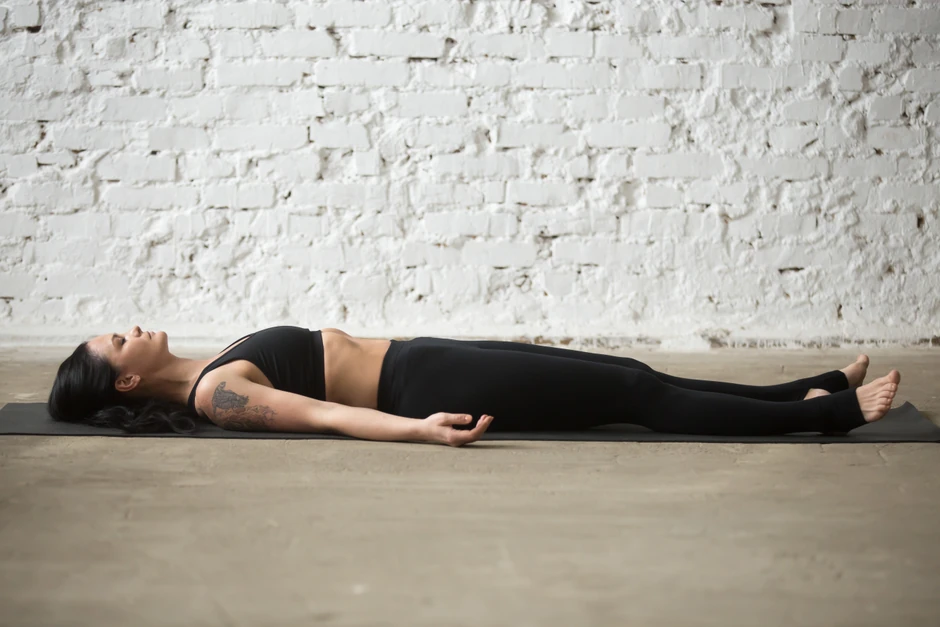
While this pose may seem deceptively simple, it’s one of the most important yoga postures you can practice. Corpse pose will help you de-stress, relax, and fully integrate your yoga practice.
Sit on your yoga mat and lower your body to the floor, relaxing your legs and letting your arms rest on the floor at your sides, palms up. Keep your eyes closed and focus on your breathing. Relax the muscles in your face and neck, and visualize every part of your body letting go of all tension. Hold this pose for 5-7 minutes.
Yoga is an excellent practice for dancers because it helps to improve flexibility, balance, and strength, which are all essential components of dance. Yoga postures are designed to work the entire body, and as a result, they can help dancers to develop the strength and stamina necessary to perform at their best. In addition to the physical benefits, yoga can also help dancers to reduce stress and anxiety, allowing them to focus more deeply on their performance.
Yoga is beneficial for dancers in many ways. One of the most significant advantages of practicing yoga is its ability to improve flexibility. Dancers need to be flexible to perform at their best, and yoga can help them achieve a greater range of motion in their movements. Additionally, yoga can improve balance, which is essential for dancers who must maintain precise alignment during their performances. Yoga can also help to prevent injuries and promote overall wellness, making it an excellent complement to any dancer's training regimen.
If you're a dancer looking to incorporate yoga into your practice, there are several things you can do to get started. One of the best ways is to find a yoga teacher who has experience working with dancers. They will be able to tailor their instruction to your specific needs and goals. Additionally, you can look for yoga classes that focus on flexibility and balance, as these are areas that are particularly important for dancers. Finally, consider incorporating yoga into your warm-up or cool-down routine. This can be an excellent way to begin incorporating yoga into your dance practice and help you see the benefits of yoga firsthand.

Receive personalized guidance tailored to your unique fitness goals, live with a dedicated coach—no credit card required.